I Can't Go On, I'll Go On
This week on HowlRound, we continue our exploration of Theatre in the Age of Climate Change begun last April with this special series for Climate Week NYC. How does our work reflect on, and responds to, the challenges brought on by a warming climate? How can we participate in the global conversation about what the future should look like, and do so in a way that is both inspiring and artistically rewarding? Kendra Fanconi is a fellow Canadian and theatremaker who, in the last few months, has been watching the forests of British Columbia go up in flames. Addressing climate change in her work in not an abstract concept, but a real and immediate concern that is deeply rooted in a sense of place. —Chantal Bilodeau
Beckett said it.
“I can’t go on, I’ll go on.”
A statement from the Anthropocenic age. The epoch where human activities started to have a global impact on Earth’s ecosystems. The age of climate change.
“I can’t go on, I’ll go on.”
We get it, don’t we? I hope you don’t mind that I included you in that. I operate under the assumption that what I feel and what my audience feels are the same, and that I can refer to us as a “we.” “We like this.” “We want this.” “We need this.” But strangely, you, as you read this, you are actually my audience right now and I don’t know you well enough to know if I am like you. I accept that I may be the canary in the coal mine, and that you are not feeling this yet but I would propose that you will be, we all will be, that this quote sums up our lives, as real as the death of the newspaper, the wristwatch, and the oceans.
Okay, hang on, did someone really just say “death of the oceans?” I think I need to lie down for a minute. I’m not ready for that today. I need another coffee. Or a peek at my newsfeed. Maybe someone got married, went to Italy, or had a nice squishy baby. Or maybe my cousin in Washington State who just had a nice squishy baby is going to lose her house to a wildfire.
“I can’t go on, I’ll go on.”
I look at that quote. I note two things. “I can’t go on” speaks to the truth of everyday grappling with climate change. “I’ll go on” implies action.
“I can’t go on, I’ll go on.”
And, friends, theatremakers in the age of climate change, I propose to you that somewhere within these seven words is our stage.
I’m part of The Only Animal. We make original theatre out of a deep engagement with place. We’ve made shows in theatres of snow and ice, of sand, in swimming pools, and on working waterways an acre wide, with birds, boats. and a bicycle ballet. Because we work with place, we work with climate change. We made NiX, theatre of snow and ice as a part of the Cultural Olympiad in Whistler in 2010. It was the warmest winter in 126 years. I remember coming out of our snow theatre during tech and kicking at something funny on the ground. Where there should have been four-foot snowpack, there was grass. Our theatre was melting.
“I can’t go on, I’ll go on.”
The Only Animal have always had environmental awareness. Sickened by the familiar sight at strike of the five-ton loaded to the dump, we set the intention to be a zero-impact company, looking to minimize and offset our carbon footprint. We paid attention to where we sourced materials, hoping to divert them from the waste stream, and looked carefully at where they ended up. We haven’t always been successful at “zeroing,” but our mandate highlights sustainability. And, you know, that felt like enough.
Then we started making a piece in an old-growth forest near our home in the tiny town of Roberts Creek, on the slopes of Mount Elphinstone, outside of Vancouver, BC, where our company is based. It’s an adaptation of Paul Harding’s Pulitzer Prize winning novel Tinkers. Tinkers is an ecstatic love song to the natural world. It is transcendental, proposing that Human = Nature = the Divine. The piece is off-grid, a roving show with twelve locations. A new addition to our creative team is German environmental artist Cornelia Konrads, who is making large, gravity-defying installations in some of these sites: a moss carpet that wants to fly, a cedar shake doorway that floats away, liminal green windows that are woven into the forest. The work seeks on many levels to integrate the site into the story—and into ourselves. It is a production that combines professional actors with cameos/choir made of locals, weaving the place into the heart of the production.
‘I can’t go on, I’ll go on.’ And, friends, theatremakers in the age of climate change, I propose to you that somewhere within these seven words is our stage.
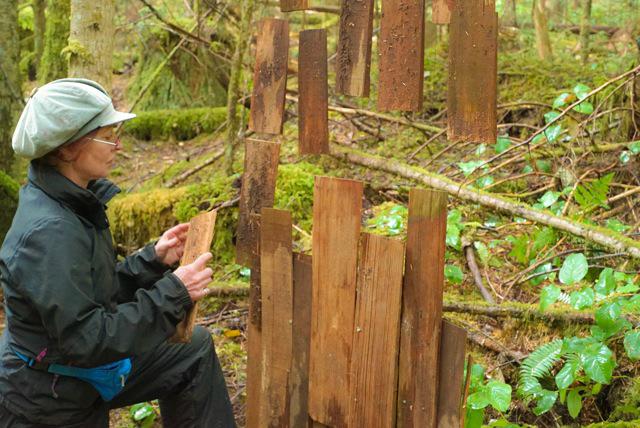
And we are siting the work within an old-growth forest—a large carbon sinkhole that is part of the climate change solution—that is being logged. Like, right now. I am writing this at 4:54 a.m. and the trucks are on their way to cut block A87126 and its 600-year-old yellow cedars. And a roadblock started 54 minutes ago. A few local activists are there. Later I will make muffins for them. But right now I am making theatre.
Why?
I believe that the fastest way of traveling to the human heart is through stories. These natural places have stories to tell, but we are losing the ability to listen. I include myself in that. I’m caught in my to-do list, I’m plugged into a podcast and the trail is just a treadmill, or I’m yakking on the phone the whole time. The forest is just a big green wall, and I don’t really know how to get in.
Theatre is a way for us to get in. Maybe it is even the best way.
The forest knows height in a way you and I never will. It is thinking backwards in time down to the ground. This mountain slope has a memory that is geographic. It remembers when the Earth folded rock and the sea drowned valleys. A beach remembers high tide. A snowflake remembers the sky. Like these sites, I, too am made of minerals and tidal waters, I know these upheavals. I’m begging these places to remind me who I am. To fill in the part of my story which is elemental, eternal, absolute. Right now, I need a mountain inside me, I need this story.

Theatre. In and of itself. Inherently. Is it the answer? Or is it just a thing you buy, like a pair of shoes that is pretty and distracting? Is that two-hour show ready to meet the challenge of the anthropocenic age and affect meaningful change?
The deeper background to my own practice is that I was raised by a political activist. My mom had me on the picket lines before my eighth birthday. I stood with her when she testified. I wrote letters with crayons that spilled out of the mailbag onto the county commissioner’s desk. She won some and she lost some. Oh, then came the Bush administration and she lost them all.
Naturally, I rebelled. I rejected the notion that protest was the way to create change. I looked at studies and stats and facts and chose fiction. More than that, I chose magical realism, that form that purports that the inner world is truer than the outer. I justified that creating site-based work was in itself a political act. I wrote this in grant applications. My work makes the real world the stage and changes it, creatively, impossibly, with a vision for something more. And I feel that this does, on some level, challenge our audience to transform the world.
But that was yesterday, that was last year, that was two shows ago. The present is not a time for “on some level” subtlety. Thematic resonance is not enough. I got to a point this spring where I just decided I needed to put climate change on my to-do list. ‘Cause I am practical like that. It’s the only way to get things done.
So I made categories and I said, “Every day I want to take action on climate change in a personal way, within my community, and a national/international arena.” And so, every day, I would do a brainstorm. (I get up early, right?) The personal was easy—I have daily work of homesteading for my family to get us off the grid, and reducing our carbon footprint. So I plant the beets, forage the mushrooms, plan the micro-hydro. I break it to my kid that we are not driving ten kilometres to Starbucks for a muffin. The community level took effort—I ask the principal of my older son’s school what are they doing on the climate change issue, I come “out” on the issue locally, and when I am buying beer at the general store and the talk turns to how hot it is this year, I call it climate change and talk about the local initiative for a solar co-op. On the national level, I try to get educated. (This is hard, I have a brain wired for fiction, and now I am trying to retain facts.) I sign up for 350.org and climatereality.com’s newsletters. I sign every online petition I can. I write letters. Still, it is a tall order. How can I begin to make a difference? It’s so, so daunting…
“I can’t go on, I’ll go on.”
I go on making lists for daily actions on climate change, but mostly I work. I run an independent theatre company, right? So, sixty hours a week, I work… And I am in the middle of Tinkers, and I start looking at that.
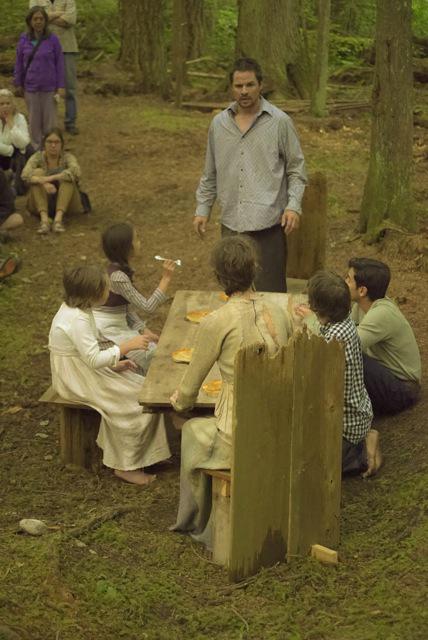
Photo courtesy of Kendra Fanconi
Tinkers is sited on private property, this old growth forest I mentioned. It’s ten acres. But of course, ten acres isn’t a forest, it’s a stand of trees. The property is part of a much larger forest—much of it old growth—that is slowly being logged. Not by a multi-national corporation, but by local and provincial government. I know about it because there is a local forest watch group. Elphinstone Logging Focus (ELF) is putting forward a plan to preserve 2000 hectares as a provincial park. (That’s sort of like a national park, for all of you Americans out there.)
I get involved with ELF in small ways. I come out with ten others for “groundtruthing” on a proposed cutblock to count and measure the girth of old growth Douglas firs that aren’t listed in the government assessment docs. After we count, the ten of us sit on the logging road and the talk turns to recipes for road kill. This is a very select audience, I think, those who are activated to save this forest: those with coyotes in deep freeze. I can rally a bigger audience, I think.
But the two-week theatre run of Tinkers is maybe not going to do it. It is a part, but not the whole. I need more engagement, more events, a buildup that can build the movement, that can maybe culminate in Tinkers next summer. What if we could open the show and the provincial park at the same time? That’s a vision! And so I approach Ross Muirhead who leads ELF. They regularly lead hikes into this endangered forest to stir up public support. I talk to him about partnering.
The forest knows height in a way you and I never will. This mountain slope has a memory that is geographic. It remembers when the Earth folded rock and the sea drowned valleys. A beach remembers high tide. I’m begging these places to fill in the part of my story which is elemental, eternal, absolute. Right now, I need a mountain inside me, I need this story.
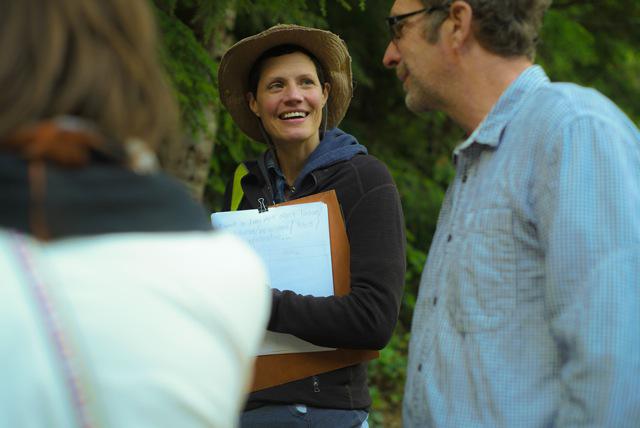
Which pretty much brings me to the present. Where I doubt what my one body can do to combat climate change, I have faith in what this forest can do. The Only Animal is committed to the preservation of this rare, coastal, old growth forest, this beautiful and valuable carbon sink. A Simon Fraser University study from 2010 says, “The researchers conclude that when a conventional, narrowly focused valuation of forests is broadened to assess the value of forests as carbon storehouses, recreation sites, and sources of products other than timber—wild mushrooms, for example—increased conservation wins out over logging in most cases.” We agree. The Only Animal’s work is to push it to the tipping point. To engage an audience and connect them to this place. To activate that audience towards conservation. Our community is 10,000 people. I think we can reach 3000+ of them through our live events. More on social media. It feels hopeful, doesn’t it?
So now, we aren’t just mounting a production of Tinkers in the forest for a few weeks next summer. We have created ten months of programming leading up to it, with monthly theatrical activations in this endangered forest, including, Trail Mix: a mixtape musical adventure, an illuminated hike on the longest night of the year, an event with puppets made of only forest floor materials, an interspecies song collaboration called Dawn Chorus. If our local community has become disconnected from the forest then we are matchmakers. We are setting them up. We want them to fall hard. Doesn’t it make sense? That you could connect people with place and then that they would act to save it?
Still, I have so many questions.
How do we make activism palatable? The old paradigm was outrage to action. My generation is more likely to go from outrage to overwhelm to Candy Crush. How can we be reached? Urban Dictionary defines solutionary as “A type of revolutionary who makes change by providing a better way to do things.” The Only Animal love this word: it appeals to us as innovators. Can we be solutionary thinkers here? Can we innovate activism?
In our year of theatrical events, we plan to creatively document each piece in short form and feed our social media networks the bites. We know our work is sticky. Folks will share it. That is part of the public awareness piece. Maybe it can translate to public pressure. And we hope those documentation pieces themselves will market our movement to the decision makers. Our forest watch partners will help on that front. If people are too jaded/busy/whatever to go to their representatives themselves, then we will document them, their voices, their presence, their stand and take it forward ourselves.
Still, the questions. Can we save a forest? What is the to-do list? That’s what drives me crazy about trying to affect change in the political system. It’s so nebulous what one actually has to do. But, like any project prep I have ever done, I know I have to prepare my best plan, and then trust that better ideas will come in the room. Or the forest, in this case.
As the logging trucks are driving up the road.
I can’t even…
I’ll go on. It feels better to be in action than to be in despair. I’ll go on. I’m “out” on the climate change issue. It’s my work. I’ll go on. Creatively, with hope, with beauty. With a love of the impossible. I’ll go on.

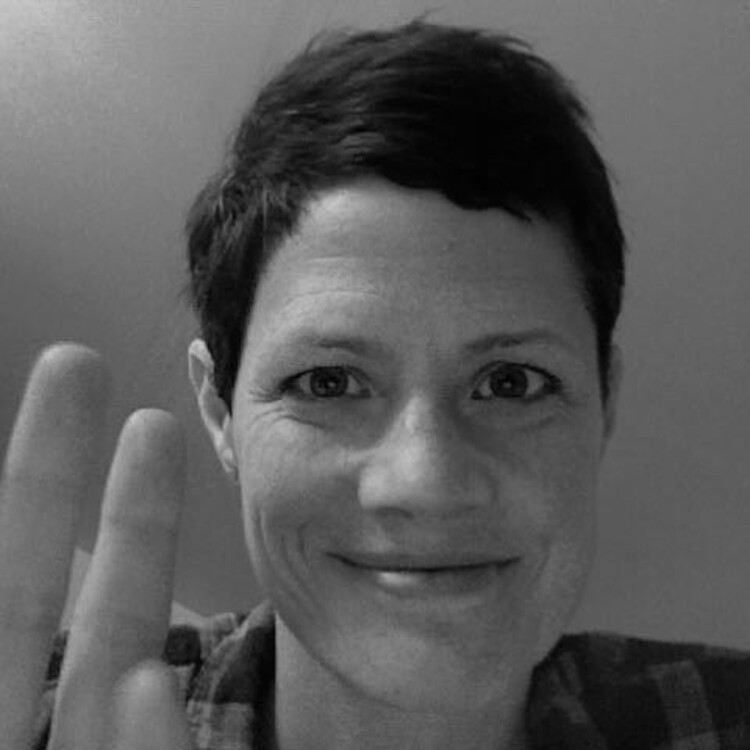
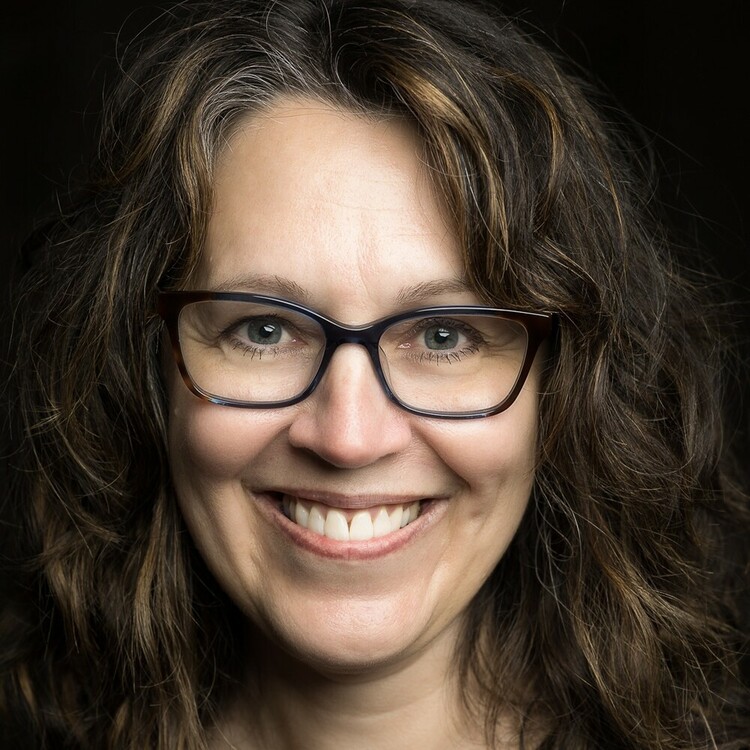
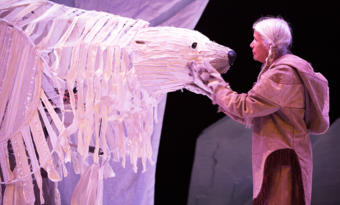








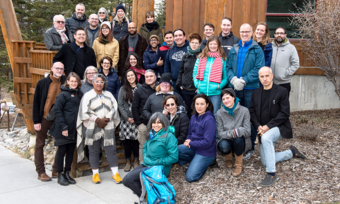

Comments
The article is just the start of the conversation—we want to know what you think about this subject, too! HowlRound is a space for knowledge-sharing, and we welcome spirited, thoughtful, and on-topic dialogue. Find our full comments policy here
INspiring! its the only way we can go on...thank you for your efforts and inspiring others!
Sentiment without action is death to the soul. Go Kendra.
Lovely article! Wonderful work! And I adore the comment: "I believe that the fastest way of traveling to the human heart is through stories."